Link building is essential to outrank your competition.
You know it, I know it, our company specialises in it. Let’s talk about some strategies we use to achieve this.
In this post we’re going to be giving away our 7 favourite link building strategies to build high quality, relevant backlinks to your website and improve your organic rankings, increase referral traffic and make more money in the process. Your very own, actionable link building 101 guide, if you will.
Link building is a challenging marketing technique but as you can see, the benefits far outweigh the difficulty it takes in getting them. Each dollar/pound you put into building premium links provides massive, consistent returns as long as your website is up and running.
Contents
What Is Link Building? (Link Building Definition)
Link building is the process of generating clickable backlinks pointing from one website (the linking site) to another website (the target site, usually a client or personal website you own.)
Benefits Of Link Building
5 years from now, link acquisition strategies will be very different – but there’s no denying that links are going to be more valuable and reliable than they are today.
Look at link acquisition as an investment – every dollar you have today will be worth more in future, and every link you acquire today will be more powerful in future.
Link building itself has 2 major core benefits:
- Higher Organic Rankings – Probably the single most important reason to build links. The more high quality links you have pointing to your website, the higher you will rank. Links are still the #1 ranking factor and moving into future this won’t change.
- Increase Referral Traffic – The links you are building will be clickable & likely built in front of your target audience already, this of course means if you are talking about a topic they are interested in, they will likely click through to read more about what you are taking about. Simple, effective and incredibly profitable.
So, without further ado, let’s crack on with 7 link building strategies we use regularly. If you need help from link building experts who know to scale your link building campaigns at low costs and high ROIs, do feel free to request a free, customised proposal.
1. Digital PR – Do Something Newsworthy & Tell People About It
Many a small thing has been made large by the right kind of advertising – Mark Twain
Rocket science I know…
This is, if you ask me, right at the top among the most ignored, misunderstood and underutilised link building techniques in the entire link building community.
Link building is essentially digital PR nowadays, building out mentions for clients and businesses on other “sources” that then link back to the “resource” as a “reference”….. Sounds familiar?
Of course it does, because it’s almost the definition for old school public relations – just adapted to the digital.
The way the game is played is slightly different here, but the goals are still the same. Generate mentions from your business at other locations where your target audience may be.
So how do we do this as a small-medium business owner without £20,000/month to pay to a PR agency?
Below are the 3 steps we integrate for clients who are looking to build editorial links and generate the old-school PR buzz.
A. Find and build rapport with the top freelance journalists in your industry
Pretty straightforward and simple, right?
It’s not.It requires a lot of patience, especially if you are in a highly competitive niche. Finding contributors who already write for sources you are looking to get featured in and simply reaching out to these individuals in a way that enables you to build a relationship and eventually later down the line, ask these individuals to post for you on these target sites.
In the words of Brain Pathway:
Building rapport is key to establishing the environment in which successful communications occur.
How you do this varies. From offering freelance writing gigs, sending free stuff, or my personal favourite, doing something newsworthy and interesting in the first place and then simply making them aware of it.
If you ask a stranger to do something for you (say post in a high quality editorial website) – The chances they will do it are slim.
Whereas if you build the relationship with someone and then ask them, conversions increase drastically. Links that seemed impossible to generate, now are well within your grasp.
B. Do something awesome, cool, interesting, unique, charitable or just straight-up newsworthy.
Doing this makes generating links 10 times easier (which means you’ll build ten times more).
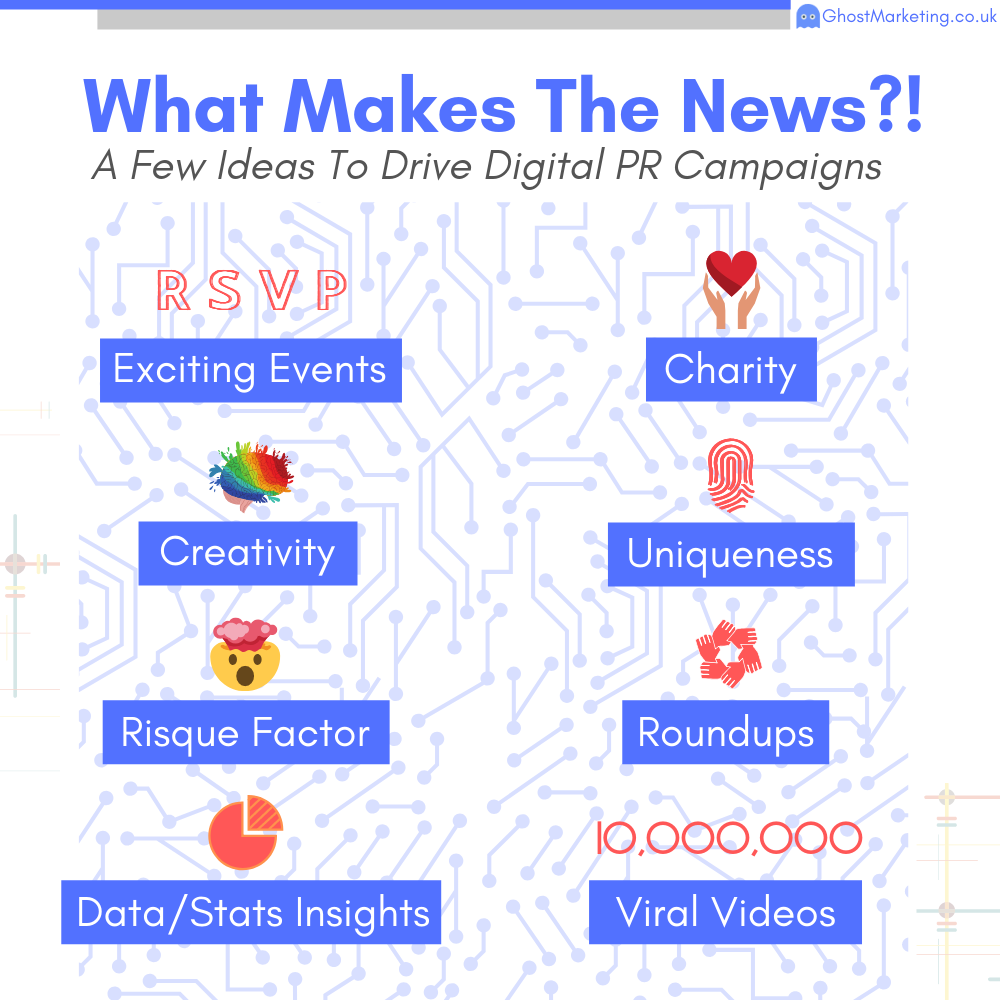
There are hundreds of examples on how you can do this, below are 9 I personally like;
- Run an event.
- Give a bunch of money to a relevant charity.
- Build an awesome tool/software.
- Reverse graffiti.
- Do something unique.
- Do something risqué.
- Build a roundup list (more on that later.)
- Format Data into a very interesting way (such as this absolute beautiful campaign.)
- Build a viral video (such as this). It now has over 25 million views.
C. Tell Part A About Part B
Simply reach out to people who you’ve built a relationship with before to tell them about your news piece. Or, in other words Part A + Part B = LINKS .
The important part is really getting a “good enough story” that makes sense for the publication to talk about.
Asking a journalist you met yesterday to publish something about how awesome your business is, well, not going to go well. (Even though many industry rookies will try to sell you this as Link Building 101. Trust me, it’ll do nothing but waste your time.)
Scale this method by starting with smaller editorial sites in your industry and “moving up the chain”, a popular marketing strategy coined by Ryan Holiday.
2. Smart Guest Posts – Don’t Be Generic
Guest posting is a strategy that’s becoming more and more generic and saturated by the day. Almost every link building tutorial out there will tell you how guest posts are the key to building links. Guest posts work – I’m not saying they don’t – it’s just that times have changed, and 2012 guest post strategies are useless now.
As we’re all aware approaching a webmaster and asking to “post a great piece of content” out of the goodness of your heart is a powerful link building strategy. At least it used to be. I mean, what could go wrong?!
Nowadays it’s just annoying and quite dull to do from a marketing agency point of view.
The basic point of using guest posts is to build links on websites that have high authority in their field. These sites will be ranking significantly better than your site for a competitive keyword so to compensate, you post on their site to redirect their traffic to you.
See Cafe Mom for example. They have high authority and have a great niche:

Guest posts or blogs can be a powerful tool to use to build links. They also happen to be among the ‘ethically’ white hat and link building best practices.
However, I see a lot of mistakes in the way people approach guest posting. The most common and senseless mistake is approaching non-compatible/useless sites for guest posts with only one aim in mind: ticking ‘guest posting’ off the link building strategies checklist.
The issue of course is that every other smart business person looking to grow their link profile is doing the same thing. This means it’s just not working all that well anymore.
Instead, you have a few options that can be boiled down to 3 strategies to build guest post links more efficiently.
3 Ways To Build Guest Posts More Effectively
A. Add a win-win element

Guest posting is one of the classic win-win elements on its own. You get a link, the website gets a “great” piece of content that will rank organically and generate eyeballs which of course equal money through many different monetisation strategies, most commonly display advertising.
But we need to integrate another “win” on the side for the website containing our content. Sponsored content is one way of doing this (pretty popular with large publications, too), but it is somewhat problematic from the Google ToS point of view (although, it’s still very much possible to scale this strategy if you have the budget for it).
So instead we like to integrate a win for the site we’ll be posting on by telling them more about you. Let them know that you have a pretty strong email list and healthy social media presence – all of which will be used to channel the content.
Another common method is to play the “I’m a key person of influence in my industry.” Of course you must have some type of influence or authority otherwise you come across like a bit of an idiot when you play this card. The easiest way to avoid this is to show where your content has been featured in the past.
B. Exclusivity
This strategy works very well for sites that are a little higher level and although accept guest posts, probably get hundreds of requests a month for people to post and hence can be very selective with who they take on-board. If you are not very “important” or well known in your industry, this is the card to play.
Exclusivity strategy essentially revolves around the “we’ve built/done/have a very interesting case study/piece of data/something that your readers will like” – We wanted to post it on your site first and exclusively because we’re only a small blog and it wouldn’t get as much exposure there and we “really want a lot of people to see this.”
If you have an interesting element, this strategy works incredibly well.
The keys here are to position yourself and your data/piece of content very carefully. It’s a bit of an art and you’ll need to know who you are dealing with, so it’s always better to check who it is you’re emailing and what they are like generally before emailing. As you may have noticed, this isn’t exactly an organic link building strategy to begin with – but once your post is live, you can be sure that it’ll attract more links to the guest post, and you can approach these secondary links to link back to you (responsible webmasters don’t really mind giving links out where the credit is due). This is nothing but organic, small scale tiered link building.
This also works incredibly well with the first strategy when you are building a relationship and rapport with the individual first. In fact, life works a lot smoother if you can combine these two link building strategies!
3. Hyper Specific Niches & Bridges
Hyper specific niches are pretty self-explanatory – If you have a website or business that you want to generate links to, chances are it’s in a niche. But you want to sub-niche down until you have a very specific niche/industry. The reason for this is because you can then build rapport with site owners a lot quicker and you’ll also know the targets and topics they’ll find interesting to pitch as titles here too, leading to a good outreach to link ratio.
Bridges work on a similar basis but focus on crossing the niche bridge. For example, let’s say you have a business that sells boats. Chances are you don’t have a huge amount of guest post opportunities that aren’t competition if you are looking for “guest posts” + Boat(s).
I actually ran this through Ahrefs out of curiosity and I was right, there does not seem to be many:

So, by creating small and then larger bridge pieces of content we can essentially generate unlimited links and keep content relevant at the same time.
For Example:
Sailing and boat maintenance could be two topics that are very closely related. As we bridge out further we could build pieces of content on topics like “The Most Expensive Boats And Yachts In The World”.
This opens up numerous link opportunities in the money, finance, lifestyle and business niche. And moving the other way we could build out pieces of content around “Best Travel Locations To Visit By Boat” – This opens up travel and lifestyle outreach options, whilst at the same time keeping everything very specific to our end target topic and not drifting too far away from our target audience.
Case Study
Link quality is more important than link quantity. Don’t know how many times I’ve had to say this, but probably for the next decade I’ll still live by these words.
In the first month of 2018 we built 18 links for a client within 6 months, that’s only 3 links per month. Not that great, right?
WRONG!
The average yearly ROI for these links was £12,000 PER LINK. Yes, you read that correctly.
Every link was built on sites using either guest postings or resource links and the essential element was focusing on the brand in question and building small bridges as the niche was so specific. You can read the full story here.
3. Expert Roundup Content Creation
This is one of the very common link building tactics in the internet marketing & SEO space, but it’s extremely underutilised in other industries/niches. That, as I see it, creates widespread opportunities for us.
For anyone who’s not familiar an expert roundup is simply a piece of content built on your website that involves quotes, advice, opinions or data from a number of experts or different sources, all of which are usually in the same industry. You can see a an SEO example below by Ahrefs.
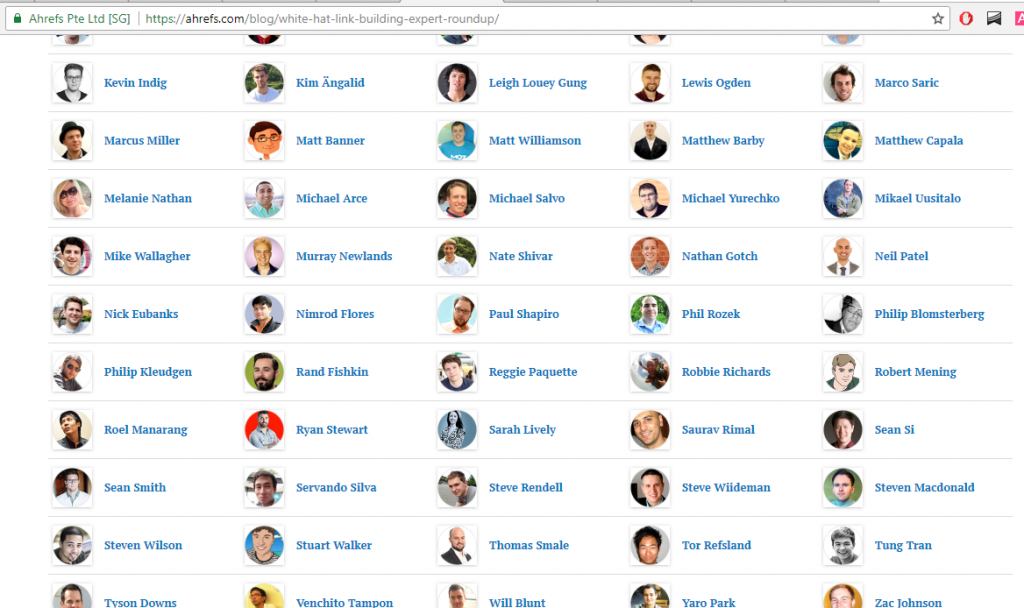
This strategy is very time consuming to build out and occasionally doesn’t add a huge amount of value to the reader as sometimes it’s done just with the goal of generating links so very little content formatting or strategies are implemented. The one I’ve mentioned above, however, is a great read.
Moving away from the SEO space.
This strategy works incredibly well outside of the digital space for 3 reasons:
- The people who you reach out to are generally happy to talk about themselves and by playing on the ego you can get them to open up and build that relationship!
- There’s no one else doing it in your area (probably.)
- As a result of the above it’s easier to rank high competition keywords by using this strategy.
The Strategy Itself

1. Find experts/industry key persons of influence and reach out to them and build the relationship. Remember to keep your email short, explain why you are doing it (come across passionate) and above all else get them to give you some sort of information and explain the incentive to do so. This is usually a link back to their site, you get to say you are featured alongside <insert big name in the industry here> and we’ll be advertising this to our list and social followings of <insert big number if you have one.>
2. Format the results and continue building relationships with these individuals. The key thing we’re going to do is email them as soon as it goes live and (hopefully) they will link to this post in a future post. We can use this post in future link building strategies, most commonly resource page strategies. They also fit well into guest posts.
3. Build out the post in a formatted way, including something of value with external links to contributor sites. For example, if you asked experts about their top 3 favourite link building strategies, build out a poll, graph or infographic to clearly display the information. Content formatting is really important and but sometimes overlooked. There’s a couple of good guides on this topic featured here, here and here. Those three sites all have information that’s very easy to read and it’s mainly due to the content formatting.
4. Resource Pages
Resource pages will look something along the lines of this:
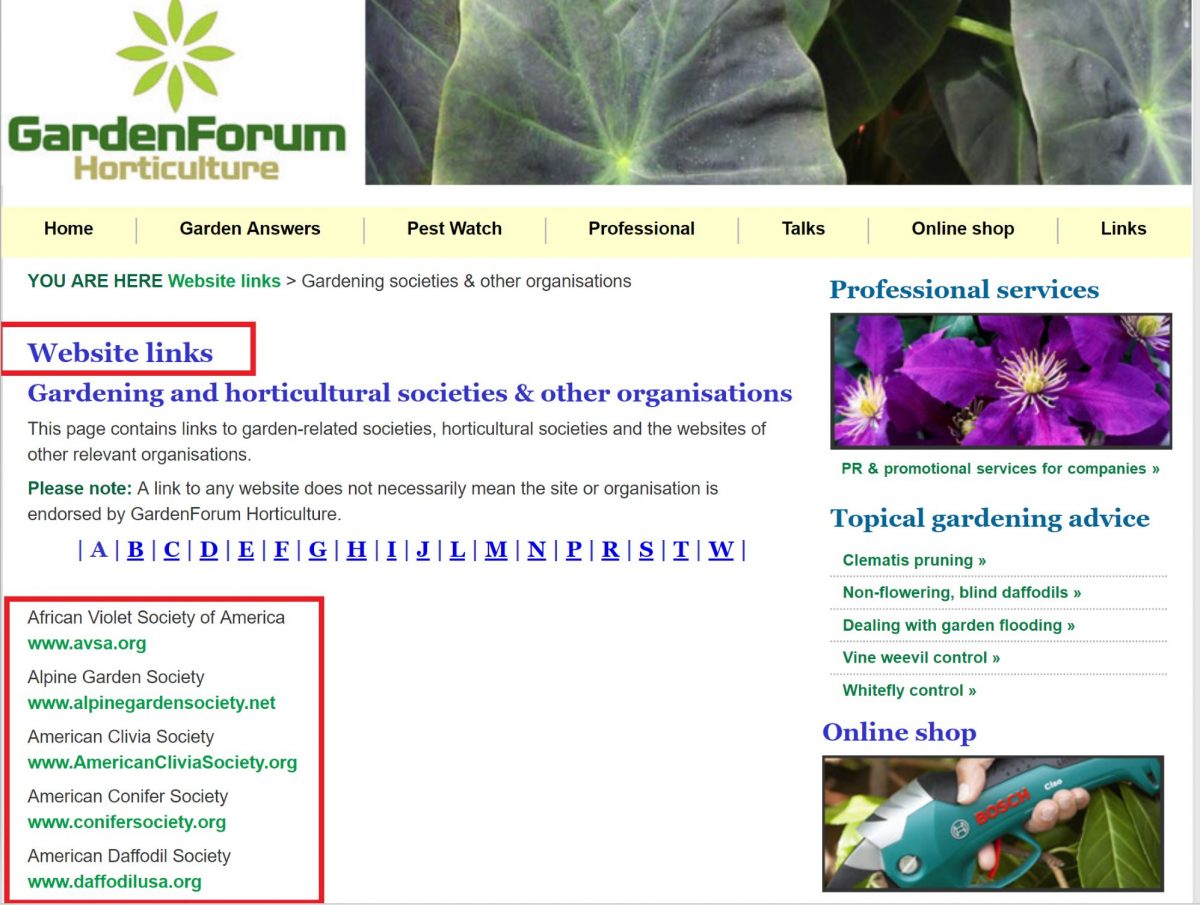
They’re a very easy concept to understand:
- Find a piece of content that generates a lot of links already.
- Make huge improvements on this piece of content, re-write all elements and build something truly epic on your website.
- Reach out to sites linking to this piece of content and instead of linking to that “cr*ppy piece of content, link to ours instead.” – Maybe not the exact script to use.
All jokes aside, resource links are awesome for a few key reasons.
Resource backlinks are usually on high authority sites that have been around for ages and have years of natural trust. These lists are also quite easy to find if you know how to search (which we’ll explain below.)
Some people also call this the “skyscraper strategy”, as coined by Brain Dean, but the strategy itself has been around for years in offline marketing not just in SEO.
How To Find & Reach Out To Resource Pages
Recommended: Our resource page link building guide discusses this strategy in great details. It also includes a free, downloadable Resource Page Finder tool that can automate much of your search process.
As mentioned above the first stage is to build the best piece of content for that particular topic. For example, we’re aiming to develop this post into the go-to link building tactics guide for people worldwide. Once that’s achieved we can reach out to sites with link building resource pages and simply ask to be added or replace an out-dated one.
Once you have your piece of content, find and reach out to the resource page and request the placement. The content must be relevant to the page it is being placed on.
In this guide, we are not going to explain the exact messages used to be able to achieve this as selling a webmaster on a resource link placement is very similar to selling someone on a guest post placement. The most efficient way to find relevant resource pages is a Google search. There are multiple ways to select a resource page from the search results:
Filter by page title and URL
Resource pages will include the word ‘resource’ in their page titles and URLs respectively.
We recently worked with a client whose business operated in the footwear niche. Searching for ‘shoes resources’ brings the following results:

Enter certain phrases as part of your search to narrow down the number of results. For example, the keywords followed by intitle:resources finds resource pages.
For our footwear niche example, we get the following:
 As you can see, we have gone from 395 million to 776 thousand. Tell Google what you are specifically looking for to narrow down the results. Here we have only filtered by title but the same logic applies for if you change the search term to inurl:resources.
As you can see, we have gone from 395 million to 776 thousand. Tell Google what you are specifically looking for to narrow down the results. Here we have only filtered by title but the same logic applies for if you change the search term to inurl:resources.
Here’s what it will look like.
After the search, use Ahrefs to see which pages have the most links. Use pages that have gained the most authority.
The only step left is getting in contact with the website owner or the person responsible for the resource page. It can be tricky to find an email address to use. In most cases, you will find links that say something along the lines of ‘suggest a resource’. If it isn’t so obvious, just dig a little deeper, for example social media pages.
When sending the email, give the recipient the benefit of using your content. Do not say the content is for a link building service. Build rapport with the responsible person as they have influence in the area. The better your relationship, the more posts to publish including links. Even if it’s just a single link you’re after, it will be easier to get if you both get along.
5. Broken Link Building
I’m assuming here that you already are aware of what broken links are and how you can use them for link acquisition at a large scale.
There are numerous ways of finding broken links. At Ghost Marketing, we use a combination of tools like Ahrefs, SEMrush and Moz, along with a bunch of in-house software that we have built based on our observations.
Contact the webmaster of the page with the broken link and request to replace it with your own. Dead links are as useful to them as they are to visitors. Content with too many broken links harms rankings as Google thinks the site is no longer active.
Here are ways to replace dead links with your new links. Our step by step broken link building guide discusses these strategies in greater details.
Identify an authoritative page and acquire the backlinks. Use Ahrefs to export all the links that lead back to the site. Narrow down the relevant linking pages using the search terms described in strategy 4. Once completed, extract all external links to find potential dead links.
Staying with the shoes theme, take this blog post from Hotter for example.

They have a lot of historical backlinks, some of which are broken. This site is also highly authoritative so makes an excellent candidate to request replacing dead links with live links of your own. Alternatively, if you would prefer an automated approach, this tool enables you to enter all the page’s external links and it will find all the broken links for you.
Target pages that have the most broken backlinks. The reason is obvious: the more broken links, the more of your own live links you can replace them with.
You can also target pages using keywords via a Google search. Cross reference it with Ahrefs to be sure the site is authoritative.
6. Visual Link Building (Promote Your Content Pieces & Data Rather Than Service Product Or Homepages)
Humans are more geared to absorb content in the form of images, graphics and videos than purely text.
From a link building perspective it’s a lot easier to leverage visuals, videos and infographics to generate links on high authority sites. This strategy is nothing new, but it’s actually being used less and less by companies nowadays who want to see “instant results” and hence don’t want to invest the time into building interesting, beautiful graphics or interactive content.
Let’s take a look at a few examples.
A. The Coke Infographic
I’ve lost count of the number of times I’ve shown this to potential clients and marketing managers. The infographic itself is situated here, it’s a simple design but with some interesting data integrated. In short, it’s a simple, clean, unique, interesting infographic.
Now let’s check the Ahrefs stats for this…
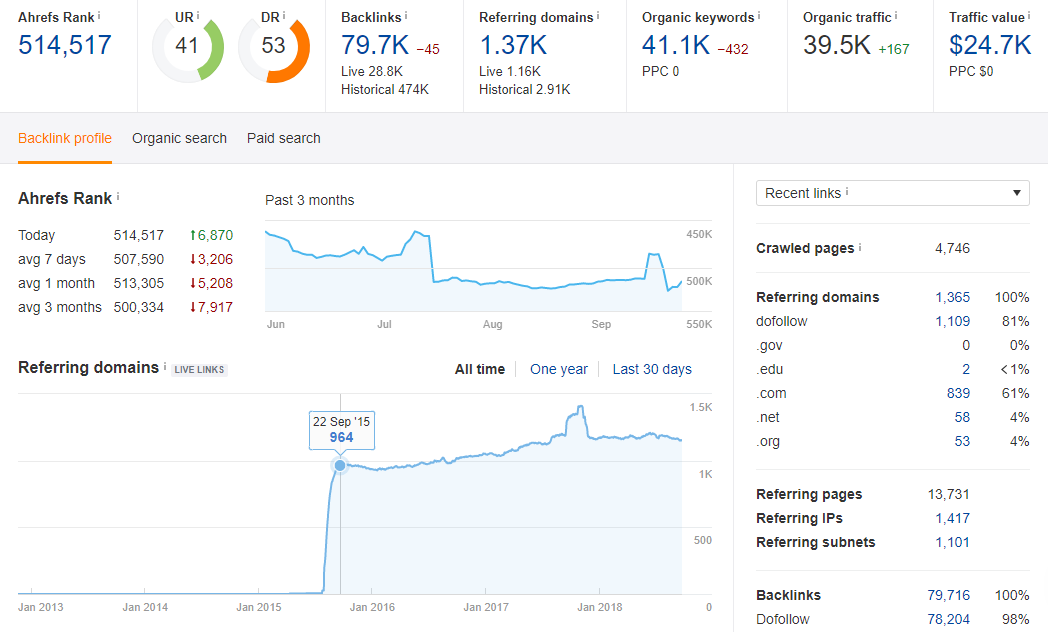
The sites this graphic was featured on were incredibly authoritative sites, such as:
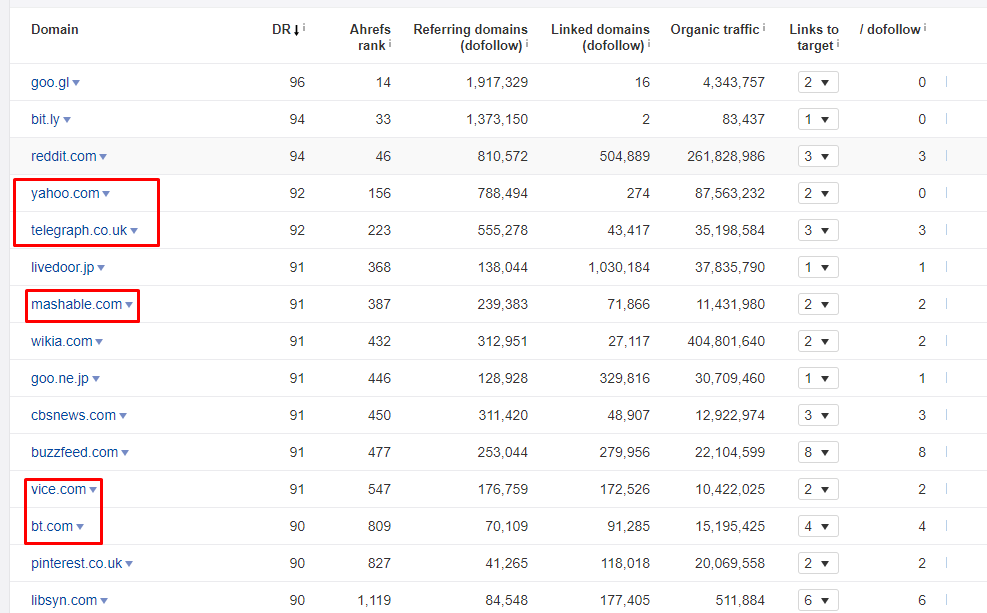
B. Export Map Example
Another favourite of mine is the graphical map format. This content involves building out static (or even interactive maps) and using these as link bait pieces. An example of this is the visualcapitalist map which shows a map of the world but replacing the country name with the top export. Super interesting piece of content and a great link building asset.
Looking into the Ahrefs stats for this piece.
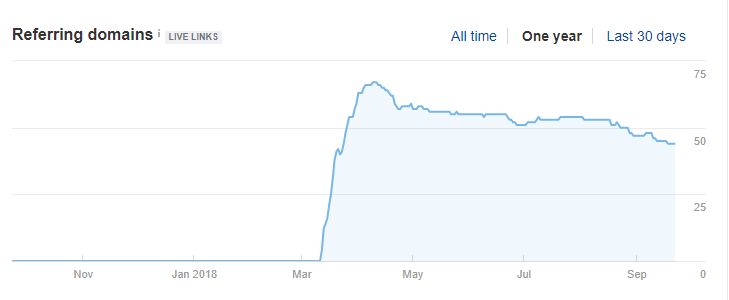
90%+ from relevant financial/investing style sites.
The key with visual content is to ensure you have specific prospects or a content distribution strategy set-up pre-building the graphics. If you simply want to build this and then share on social and expect dozens of awesome links then think again.
7. Competition Analysis & Digital PR
Link building in short involves three basic principles. These concepts are nothing new but they are time consuming. It’s why in my opinion link building is essentially digital PR for your business. In this final strategy I’ll talk about competition analysis and digital PR. I’ve done large pieces on both of these in the past on our site, so won’t dive into extreme detail but they are 2 essential elements to know.
The three basic principles of link building are:
- Content Curation – Creating an interesting or valuable piece of content.
- Connection Building/Prospecting – Who and how are you going to approach for links.
- Competition Analysis – What are your competitors doing well/badly and how can we reverse engineer links.
These core concepts are integrated into every link building strategy we use and should be built into yours or simply integrated individually.
Competition Analysis
In short, this involves looking at what your top ranking competitors are doing in regards to digital PR and link building. You can read all about this in our competitor link analysis guide, but the short version is:
- Analyse the competitor inside Ahrefs.
- Determine what they are specifically doing to generate links.
- What strategies?
- What’s the content like?
- What sites? Guest posts?
- Any resource pages?
- Are they part of round-ups?
- Are they implementing any specific black hat strategies?
- Do they have any journalist/editor connections?
- Reverse engineer the 80-20 Rule.
- What are their top 20% of links driving 80% of the organic rankings?
- How can we also achieve these 20% of links?
It’s essentially that simple, although it might look like a lot of questions, once you get used to implementing this, using tools like Ahrefs, it’s actually very easy to see what links are driving organic rankings the most. Then implementing your time/resources to achieve these links rather than looking for brand new opportunities is a great allocation of resources for smaller companies/marketing campaigns.
Never lose sight of the end goal: we want as many high-quality, relevant links as we can get. Find out what works best, fastest and cheapest, and keep doing more of it.
If you have any questions about our link building strategies feel free to get in touch.
A Few Keys To Remember
With any link building strategy, you can merge almost dozens of other link building techniques into it. For example visual link building, resource link building, broken link building and guest posts can all be merged into one campaign. The key is to get your pitch & prospecting right. The easiest way to do this is to simply reverse engineer your competitor’s outdated content pieces and “steal” their links.
For example, if we take Content Marketing Institute as an example, we can use Ahrefs to narrow down exactly their content based around link building strategies and see the links those exact URL’s have generated, we can them outreach to these sources and let them know we have a piece of content that’s more updated than theirs, not only this but it’s more in-depth too.
To do this inside Ahrefs, put your competitors site into content explorer, with the site: function (as well as the keyword you are looking to target. This looks like the below.
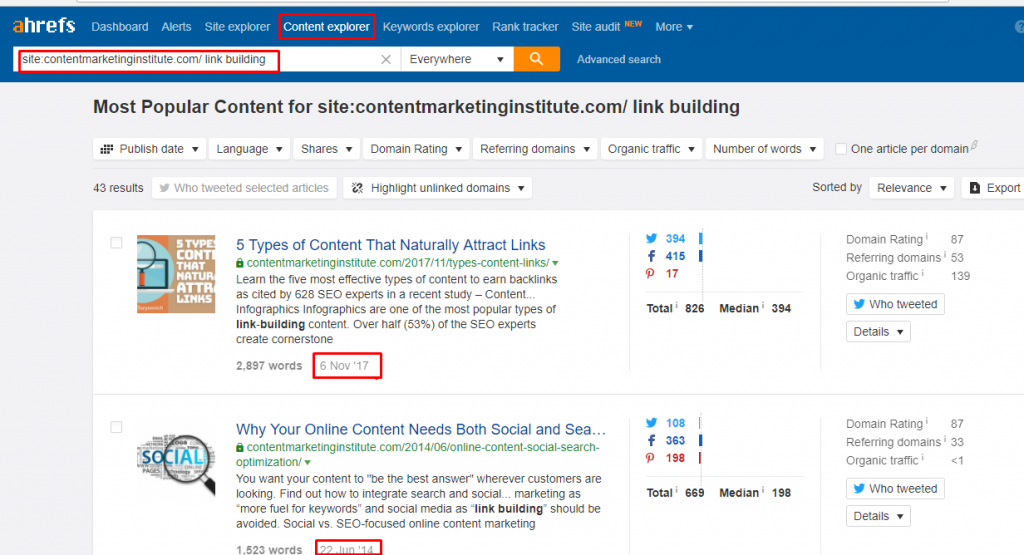
From here you can see the date the posts were published. Filter further by number of dofollow links, broken links and organic rankings if you prefer.
This gives hundreds of relevant link prospects to outreach to within minutes. Although, remember to have good anchor text diversity when it comes to these links and not dozens of anchors that all say the same thing.
We’ve built out additional guides that talk about more affordable link strategies, more advanced link acquisition techniques and even some of the core benefit of link building you can expect to receive. As well as expanding this post to include another 11 strategies you can implement today.
11 Other Types of White Hat Link Building Strategies
Below are a few more strategies that might help the link-building creative juices flowing for your business.
1. Cross Vertical Link Outreach
This technique involves reaching out to business owners in industries related to yours, but that are not direct competitors. Phrasing is important here, but as long as you are not direct competitors, it usually converts very highly.
Pros:
- Very fast, relevant links.
- For instance, building connections with PR agencies that do not offer SEO.
- You can also offer simple value exchange here.
- For example, we will do you a quick technical audit that usually costs $1,500 in return for a few links.
2. Link Aggregations
Also known as link roundups. Most link building tutorials will talk at length about this – because it’s a pretty straightforward link building technique. It involves creating a piece of content that links to number pieces that are relevant to the niche. Very similar to those Top 10 posts you find all over the internet.
Pros:
- Generate a large social impact, resulting in more direct and social traffic.
- Become known as an industry leader if you get it right.
3. University Outreach
The most powerful links you can build. We had discussed the local angle of this method in our local link building tutorial. These domains are typically characterised by high-authority, exclusive cTLDs/TLDs like .edu, .ac etc.
The easiest way to build these links is to reach out to individuals inside the Uni on their blogging platform and with some strategic value exchange, we can generate dozens of powerful links from these sources!
Pros:
- Insanely powerful links.
- Relatively cheap to obtain.
4. Sponsorship, Charity & Event Links
We group these all together as they involve a very similar link generation strategy. These are perfect for gaining locational relevance and when mixed with local value exchange, is all you need in most cases to rank! Sponsoring a sports team, event, or giving money to a charity is a great way to get an inbound link and do a good thing in the process.
Pros:
- Links from hugely authoritative websites that are trusted by Google.
- That feel good feeling. Also potentially incentives – e.g. free tickets to sporting events and additional online+offline PR. What’s not to like?
5. Paid Directory Links
Gone are the days where you could pay someone £100 to generate 100 directory links. Google now sees this as complete spam! But there are still around 10 directories that are premium and highly regulated. As a result, Google trusts these and loves businesses that generate links from them. We have a list of 8 premium directories that we recommend to all clients. These range from £40 to £800. To know more about these, feel free to get in touch with our team. You can also tweet to us to request a call back.
Pros:
- 90%+ Conversion rate.
- Great for brand reputation.
6. Local Value Exchange
In this strategy, we reach out to local businesses and bloggers and offer a value exchange. For example, a tweet or mention on our social accounts in return for a link from their site. There are other value exchange opportunities too, but if the business has a strong social following, this is usually the most effective method.
Pros:
- Really personal and great for building connections.
- Add locational relevancy very quickly, something most sites lack.
7. Non-linking Content
This involves finding locations online where your website is mentioned, but not linked.
Pros:
- For large businesses and websites there are lots of opportunities for great brand anchor links here.
- Very easy to find these types of opportunities using specific search operators in Google.
- High conversion rates.
8. Sponsored Posts
This is essentially guest posts on steroids . You pay to feature on a website.
Although these cost money to post, they usually have less stringent guidelines for postings. This means we can talk about our product’s benefits more and essentially pre-sell the products or services.
Pros:
- Allows us to pre-sell products in content. So, it’s PR/advertising + links.
- Higher quality links in most cases, as most cannot afford or do not want to pay to post.
9. Conferences & Events
Unlike the conference and event link generation strategy above, this involves HOLDING conferences and events for your business or industry. This is not only a great way to get links from a ton of industrial related websites, but it also helps increase the brand image of your business.
Of course, this will cost you money.
Pros:
- Improve your industry standing.
- Network with industry peers, experts and find opportunities.
- Offline + Online PR + Links.
10. Podcasts/Webinar
Interviewing experts on a podcasting or webinar series is a great way to get some awesome content, as well as links on a very common basis, usually from the individual you interviewed.
This also works the other way too. Take up every podcast or webinar opportunity. This goes for speaking events and conferences too.
Pros:
- Build connection, improve visibility, social shares.
- Relevant powerful links.
11. Influencer Outreach or Product Reviews
A technique that is more common in relation to general marketing and sales tactics for start-up brands. This strategy involves reaching out to potential influencers in a specific industry and simply asking them to review, or promote the product. There are very specific scripts and strategies we use in this case, but the add-on benefits are huge.
Pros:
- Great links.
- Highly scalable when done right.
- Social shares and secondary PR.
That is all the strategies you need to know (for now)!
Finally: The #1 Issue With The Google SERPs [Bit of a Rant]
Google’s search results are not proportional.
This means if you rank 5th for a specific keyword, you will likely receive around 8% of the traffic for that keyword search. For example, if a keyword gets 1,000 searches per month, you will likely receive around 80 visitors per month. If you rank 1st for a specific keyword, you generally receive around 35% of the traffic. In this case, that would be 350 visitors per month, over 4x increase in traffic.
The sites that rank first for specific keywords have the most authority for that specific keyword in the eyes of Google. To rank 1st, we must increase authority. The most effective way to do this is to build high quality backlinks, but the number of backlinks we need to build is almost always lower than you think. Let us take an example further, this is based on a client in London and the financial niche.
A Quick Note On ROI, Increasing Rankings & Revenue
Ranking 5th for this specific keyword generated one of our clients approximately £18,000 a month in revenue. In other words, ranking #1 for this keyword would generate the business around a 4x increase in revenue, approximately £80,000 per month in revenue from ONE keyword.
The client knew this keyword could be highly profitable, but they had invested all their energy into on-page optimisation and creating great content (these are important, but remember the 80-20 rule).
They could not understand why they were not ranking. One of the marketing members knew a little about SEO and they eventually found their way over to us. It’s been a great partnership for all the parties involved!
Conclusion: Organic Link Building Is The Way Forward
Link building is crucial to increasing organic traffic and rankings. These link building techniques will help you get better quality links back to your site and increase organic rankings. All the above methods discussed are instantly actionable, so get building today! Let the results come in, see what’s working and amp up those campaigns.
If you don’t have the in-house expertise it takes to implement successful link building techniques, do feel free to get in touch with us to request a free, customised proposal. To learn more about how our link building expertise has helped our clients, do take a moment to go through our link building case studies.
